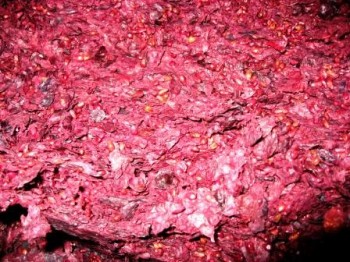
After first pressing, the remaining wine press residue left over undergoes a few more forced pressings. This wine residue is also referred to as the marc or pomace. Marc is the French term. It is comprised of all the skins, pulp, pip, seeds, stems, yeast and juice that is left over after the initial free run of the juice. It looks like a dark, almost black mush. Of course, the free run is used to make premium wines; but the second and third pressings are also used to make lesser quality wines. The final pressing, determined by the wine maker, will be discarded or turned into vinegar or brandy. The names are synonymous and can be used interchangeably.
The use of grape pomace to make brandy is an age old tradition; today it is used mainly as ruminant feed, mainly horses, for its low fiber, high nitrogen-free extract levels and as fertilizer that is placed back into the vineyard. However, modern processes are used to make things like grape seed oil and certain brandy distillations. Pomace brandy like Grappa is made from wine residue that ferments while it is still in the must. After fermentation the pomace is removed and distilled to create a high alcohol volume brandy.
Pomace, or marc, is leftover from either red or white wine production. Naturally, red wine pomace is more tannic than the white as a result of the high tannin content of red grapes. The high alcohol, high tannin level of the red pomace is what is converted to a high alcohol content pomace brandy. In white wine production, the grapes are pressed after the initial crush and the juice is collected almost immediately to avoid as much skin contact as possible. This pomace is lighter in color, almost pale green; what you would think if you were to crush white grapes into a mush. White grape pomace contains more sugar than red grape pomace, so it makes a sweeter brandy.
There is difference here between pomace brandy and brandy spirits or brandy wine. Pomace brandy is not aged. It is the direct result of distilling the wine press residue, which includes the skins, seeds and pulp of wine grapes. Brandy is distilled in the same fashion and pomace brandy but it can go through several distillations. Once that stage is complete is goes through an aging process.
In France, the wine marc is used to make either Marc de Bourgogne, a full flavored high alcohol content pomace brandy, or a lighter, drier, softer, Marc de Champagne. Marc de Bourgogne has an acquired taste. It has a sting that most tasters dislike and discount as swill, but advocates of the brandy proclaim it as a digestive. Marc de Champagne is made from the wine press residue of Champagne production and has an alcohol content of about 40%. It is used mainly as a dessert additive in truffles but can be made into a pomace brandy to be drunk on the rocks or as the base in a mixed cocktail.


Speak Your Mind